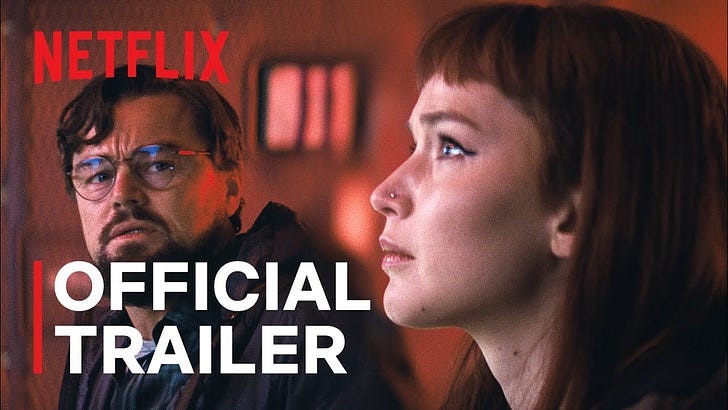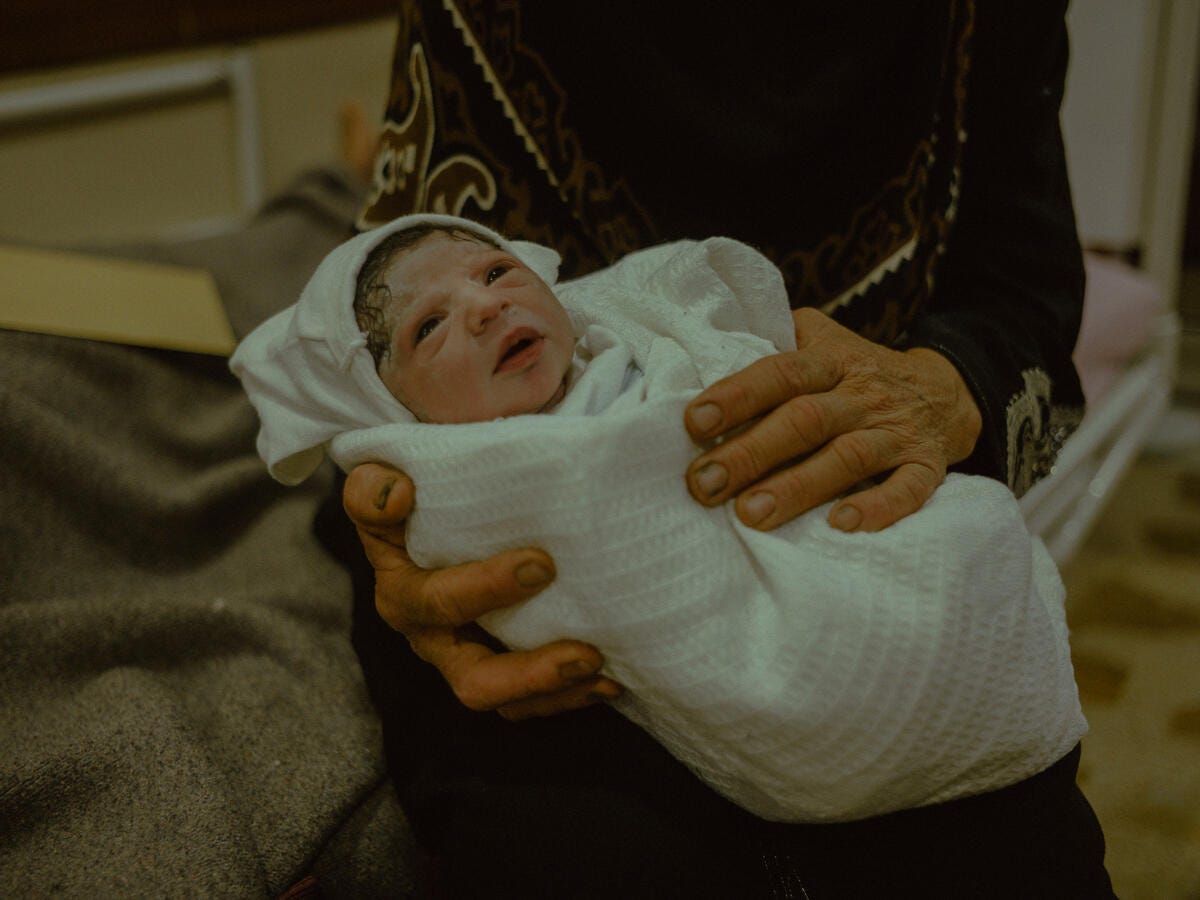4 January 2022. Satire (again). Photos.
Looking down at Don’t Look Up | Photographs for humanity
Welcome to Just Two Things, which I try to publish daily, five days a week—at least four, anyway. Some links may also appear on my blog from time to time. Links to the main articles are in cross-heads as well as the story.
#1: Looking down at Don’t Look Up
Don’t Look Up, released on Netflix over the holidays, is a satire on climate change—or more exactly, on our failure to do anything meaningful about climate change. When I say ‘satire’, the film is more like an axe than a rapier.
It’s had mixed reviews, perhaps because of this, although was apparently #1 on Netflix in the countries where it was released. There’s something to be said about the reviewers, a point I was alerted to by Richard Seymour on Twitter:

The premise, in a couple of lines, and no spoilers: Jennifer Lawrence plays an astronomy Ph.D student who discovers a new comet—and then, no matter how many times she and her Professor (played by Leonard di Caprio) do the calculations, they realise that it is going to crash into Earth in six months and 14 days.
They get the attention of the head of NASA’s Planetary Defense Task Force (this is based on an actual US organisation). He eventually gets the attention of the President (a scheming Meryl Streep), and son and Chief of Staff (Jonah Hill) who may be modelled on Donald Trump Jr. And after that it’s simple: all they have to do is blow the thing up.
Well, maybe not that simple. Independence Day, this ain’t. The film is sharp on the way that politics, social media, and mainstream media exist in a grim co-dependent soup. Mark Rylance plays, brilliantly, the sinister billionaire whose campaign contributions have bought the ear of the President, as a combination of the worst features of Mark Zuckerberg and Elon Musk.
The film is directed by Adam McKay, who directed Vice and The Big Short, and as you can gauge from the cast, this is a substantial production.
If I say more than this, there will be spoilers. But given that this is supposed to be a film that is metaphorically about climate change, it’s worth saying that—critical carping notwithstanding—the early part of the film is also acute on the difficulties that scientists have in communicating how science works to journalists and politicians. Di Caprio’s “99.74% chance” of the comet hitting Earth is reduced to 90% and then 70% in two lines of dialogue inside the Oval Office.
The other thing the film captures well, in the context of climate change, is people’s willingness to believe in the promise of unproven—and un-peer reviewed—‘silver bullet’ technologies, over things that might actually work.
As a film: the scene where di Caprio finally loses it is reminiscent of Network. And the intercut scene where he and Lawrence see the comet for the first time echoes other films, and is all the more powerful for it.
Richard Seymour also tweeted this:

Over at Current Affairs, Nathan Robinson expanded on this idea, starting from the position that the reviewers had almost discouraged him from watching Don’t Look Up at all:
(M)any said it was a heavy-handed political satire that made obvious points and was not clever. Since I find nothing more painful to sit through than bad political comedy, I thought I should give Don’t Look Up a miss. I decided to watch it when I saw that leftist investigative journalist David Sirota… had co-written the story. I know that Sirota is not stupid… If he was involved with writing a Netflix comedy, I thought it would at least be not completely terrible (emphasis in original).
Robinson’s piece is full of spoilers, by the way, so don’t read it if you worry about that kind of thing. But his view is that film reviewers—whom he quotes extensively—are, basically, reviewing the wrong thing:
One reason that these reviewers think that message is an obvious one is that they miss all the parts that are not necessarily obvious. Indeed, the film does depict a media that is more concerned with celebrity relationships than with climate (or rather, comet) science. But it does not have a nihilistic view of Americans. Not in the least, and this is critically important to understand. In fact, the film depicts an idealistic, diverse group of Americans who try their best to protect the planet.
I’ve cut this quote slightly short, because, again, spoilers. But the point that Robinson makes is that the underlying story in the film is that the obstacles to this ‘idealistic, diverse group’ trying to protect the planet come from those in power. We’re not all in this together—and those with power and money have all of the tools at their disposal to try to make sure it stays this way.
The trailer is here:
There was a significant anniversary over the holiday period—the fiftieth anniversary of Medecins San Frontieres, or, in English, Doctors Without Borders. The charity was founded in 1971, and the anniversary is marked by a book, Witnesses: 50 Years of Humanity, co-published by Magnum Photos and Medecins Sans Frontieres (MSF).
MSF has had a long collaboration since it was created with Magnum—perhaps the world’s leading purposeful news agency—because it is in some ways a creature of the modern age. Bernard Kouchner, a co-founder, had been in Biafra during the civil war at the end of the 1960s, and had realised the impact that Donald McCullin’s photography had had on the way that conflict was perceived.
In an article on the Magnum site by Fred Ritchin, Ritchin quotes Kouchner from that time:
“Without photography, massacres would not exist. Nothing can be done without pressure on politicians.”
As an aside, perhaps, one particular image of McCullin’s was etched on Kouchner’s mind, of a starving albino boy. As the article relates, it was etched on McCullin’s memory as well:
“It was beyond war, it was beyond journalism, it was beyond photography, but not beyond politics,” McCullin wrote in his 1990 autobiography, Unreasonable Behaviour. “If I could, I would take this day out of my life, demolish the memory of it. But like memories of those haunting pictures of the Nazi death camps, we cannot, must not be allowed to forget the appalling things we are all capable of doing to our fellow human beings.”
McCullin, like many other leading news photographers, was a member of Magnum, founded in the aftermath of the Second World War as a co-operative of photographers, and committed to the responsible use of photography. (Its photographers keep their copyright so they can control their images).
Of course, in 2021, photography is not as simple as it once was. When McCullin bore witness to the destruction of Biafra, no-one claimed that the image wasn’t real.
At the same time there is an issue of the credibility of the photograph, particularly in this age of allegations of “fake news” and the ease with which “alternative facts” are proffered that go against reason but serve ideologies, both personal and societal... At the same time, increasingly sophisticated “deepfakes” promise to produce synthetic videos nearly indistinguishable from actual ones. As a result, the lens-based witnessing imagery that society, including humanitarian organizations, relied upon to provoke a response may become even more compromised. Citizens of wealthier countries will be spared having to take the rest of the world as seriously.
—
(Photo © Nanna Heitmann/Magnum Photos. Noor Ibrahim, a newborn, in the arms of his grandmother Shaima at MSF’s Nablus hospital. They come from Rabia, a city on the border with Syria, 120 kilometres from Mosul, Iraq.)
This isn’t the only problem that the intentional photographer faces. In a world awash with images, it is harder to find “iconic images” that represent a conflict. Ritchin suggests that there are few iconic images since the turn of the 21st century. None from Afghanistan, for example; and perhaps there is only the shocking picture of the dead Kurdish/Syrian child on the beach. In this world, the photograph, and the photographer, need to do more:
While the photograph can still function as a visual record, that record increasingly needs adequate contextualization to give readers the tools to decipher and amplify their meanings...Imagery by contemporary photographers can strive to include the points of view of those depicted, of eyewitnesses as well as of others from their communities, and links to other sources of information online that the photographer views as credible and can provide background or help explain the systemic issues that underly that which is visible.
It’s a longer and more reflective article than I can do justice to here, and I’ve omitted completely the long struggle Ritchin had back in the 1980s to persuade a New York museum or gallery to show Sebastiao Salgado’s photographs from the Sahel. When he finally succeeded in this, the museum declined to display a phone number for Medecins San Frontieres. It was they said, ‘not seemly’.
Update: The very first post on Just Two Things was about Public Domain Day in the United States, when—on January 1st each year—a whole lot of new material comes into the public domain. In the US, this depends on the date of the work: it the UK, it’s driven by the date of the death of the author. But anyway, Jennifer Jenkins of Duke University has—as ever—written about the new works that have come into the public domains= in the US:
The line-up this year is stunning. It includes books such as A. A. Milne’s Winnie-the-Pooh, Felix Salten’s Bambi, Ernest Hemingway’s The Sun Also Rises, Langston Hughes’ The Weary Blues, and Dorothy Parker’s Enough Rope. There are scores of silent films—including titles featuring Harold Lloyd, Buster Keaton, and Greta Garbo, famous Broadway songs, and well-known jazz standards. But that’s not all. In 2022 we get a bonus: an estimated 400,000 sound recordings from before 1923 2 will be entering the public domain too! (Please note that this site is only about US law; the copyright terms in other countries are different.)
j2t#235
If you are enjoying Just Two Things, please do send it on to a friend or colleague.



